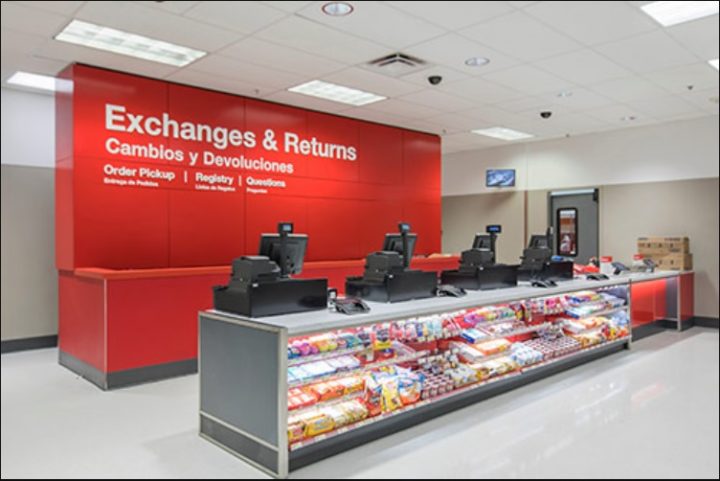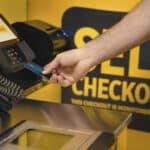
When you return an item to the store, should you be able to do it without a receipt, or must you have one? Should you get cash back, or a gift card? If you bought an item with a coupon, should you get the full value back, or the full value minus the value of the coupon?
No matter what a store’s return policy is, it’s not going to be perfect in every situation. If it’s too lenient, fraudsters might take advantage. If it’s too strict, honest shoppers might get shortchanged.
So Target might have the answer – different return policies for different shoppers. Honest shoppers get the benefit of the doubt. Dishonest shoppers don’t.
Target describes its idea in a newly-published patent application. “Method and System for Determining Return Options for Inventory Items” envisions a system that would allow a customer to “self-initiate a return of an item, and automatically receive a customized, appropriate return option based on the level of trust of the customer and the item to be returned.”
Traditional return policies, such as Target’s own, “do not factor in the customer or which product the customer is returning,” the patent documentation reads. So Target’s proposed system would consider several factors before determining precisely how a return will be processed.
Instead of waiting in line at the customer service desk, you’d go to the Target website or app to start the return process. By logging in to your account, Target will know exactly who you are – so if you have a bad reputation as a bad returner, Target will know about it.
Each customer will be assigned a “risk score” based on their past transactions. For instance, “20 return requests within the past year” might be considered “indicative of fraudulent behavior,” and the customer might be considered a high-risk returner. A customer returning a high-value item might also be singled out for some more scrutiny.
Based on their risk score, customers will be presented with personalized options as they complete the return process online. A low-risk customer might be told they can get a cash refund when they return the item in store or via mail, they might earn the ability to return an item without having to show a receipt, or they may even be given the option of getting a refund without having to return the item at all.
High-risk customers, in contrast, might be required to return the item to the store where they purchased it, or they might only be allowed to exchange it for a replacement item, or for a gift card instead of cash.
Return fraud is a multimillion-dollar problem. According to the most recent report from the National Retail Federation, customers returned some $428 billion worth of merchandise last year. And about 6% – or more than $25 billion worth – of those returns were fraudulent. Shoppers might shoplift an item and try to return it for a refund. They might grab a product off the shelf and “return” it using a fake receipt. Or they might buy a new item to replace a broken one they have at home, then return the broken one for a refund.
Couponers can commit return fraud, too. Some purposely and regularly return items they purchased with coupons, in order to make a profit by getting refunded the full selling price of their merchandise.
That’s why some retailers subtract the value of any coupons used when they give you a refund. If you use a $1 coupon on a $10 item, you only paid $9 – so why should you get $10 for returning it? On the other hand, some shoppers grumble that the store has already submitted the coupon for reimbursement from the manufacturer, so why should the store pocket the extra cash instead of giving it back to you?
Target’s policy tries to split the difference, refunding you the actual price you paid, and the value of any coupons used in the form of a gift card. But none of the present systems are going to please everyone. “Although having a uniform return policy for all customers may be simple to administer, often such policies result in lower customer satisfaction,” Target’s patent application reads. So retailers must “balance the customer’s desired liberal return policy” with the risk the retailer faces for “loss of sales and the potential for abusive/fraudulent behavior.”
So Target’s proposed new method of handling returns might help. You won’t be punished for other people’s bad behavior, and they won’t be able to benefit from your honesty. And if it helps to make a dent in the $25 billion worth of return fraud that occurs each year, then a new and improved system will ensure that we all won’t be forced to pay the price.
Image source: Target
















The Retail Equation is fraudulent & false in who they restrict. Appears they work out of a p.o. box in California and monitor the whole nation I don’t think so. Fake News….
Also this article is false & misleading stating customers can commit “fraud” if they buy with coupons then return for profit… FYI if you follow the link the next article about Walmart states “it perfectly leagl, Walmart doesn’t care nor does the law” says the judge….. So how can you say customers would commit fraud, if the judge says its legal and the law doesn’t care… Thats a flase bias. Like calling a customer a thief yet they’ve never stolen anything… Accusing them of fraud but they aren’t frauding….. Now on the other hand when target subtracts the coupons from the return (stealing the customers return values & taxes they paid) thats target doing return & tax fraud….. Yuup it target we need to look out from stealing our money & taxes we paid …. Funny how they try to blame the customer to cover up what they are really doing.
This is already being done. Take a look at companies like The Retail Equation.